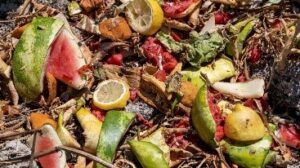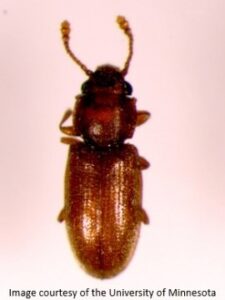Food Waste to Animal Feed
 According to “Feeding America”, each year, 119 billion pounds of food is wasted in the United States. While a notable portion comes from homes, food service, and retail, much of the waste is generated at the manufacturing level. It is also estimated that more than 55% of the food waste ends up in landfills to decompose and release methane gas. Many manufacturers recycle their waste into animal feed. While not all food waste may be safe for animals to consume, much of it can be, but isn’t. Manufacturers who wish to turn their waste into feed may reap some benefit by doing so. Some companies, who act as brokers, will pay for the waste to be collected and distributed to local farms and others will charge a nominal fee to collect and manage the food waste for the manufacturer. These two methods reduce costs for the manufacturers. There are rules and regulations around the reuse of waste as animal feed to ensure the safety of the livestock. Each state may have specific rules to follow and should be consulted.
According to “Feeding America”, each year, 119 billion pounds of food is wasted in the United States. While a notable portion comes from homes, food service, and retail, much of the waste is generated at the manufacturing level. It is also estimated that more than 55% of the food waste ends up in landfills to decompose and release methane gas. Many manufacturers recycle their waste into animal feed. While not all food waste may be safe for animals to consume, much of it can be, but isn’t. Manufacturers who wish to turn their waste into feed may reap some benefit by doing so. Some companies, who act as brokers, will pay for the waste to be collected and distributed to local farms and others will charge a nominal fee to collect and manage the food waste for the manufacturer. These two methods reduce costs for the manufacturers. There are rules and regulations around the reuse of waste as animal feed to ensure the safety of the livestock. Each state may have specific rules to follow and should be consulted.
Food waste to be recycled to animal feed cannot be adulterated, as with human food, and needs to be protected against contamination, whether it be physical, chemical, biological, or radiological. Proper segregation and storage are essential starting points. Having designated waste bins/totes, labeled for “animal feed only” are methods used to control contamination. The development and implementation of an animal feed recycling program can be rolled out in phases to reduce risk, to make it manageable, and to work out details as needed to ensure success. There are no regulations stating that a manufacturer must recycle food waste, but if one chooses to do so, they must protect the consumer, the same as with human food.
Submitted by: Rich Gibson ACE, CFSQA
The Foreign Grain Beetle
Order: Coleoptera Family: Silvanidae Genus: Ahasverus Species: A. advena
 The foreign grain beetle (Ahasverus advena) is a species of beetle in the family Silvanidae. It is related to the saw-toothed grain beetle (Oryzaephilus surinamensi). At approximately 2 mm (1⁄12 in) in length this small beetle can be confused for other stored product pests having the same shape and color. It an be distinguished from other grain beetles from its slight projections or knobs on each front corner of the pronotum, and its club-shaped antennae. Males and females are identical in appearance both as larvae and adults. The adult is usually reddish brown, or sometimes black. The adult female can begin laying eggs around 3 to 4 days after emerging from the pupa. It can lay up to 8 or 12 eggs per day, but generally produces 1 to 4. Eggs are laid singly or in clusters of two or three, and they hatch in 4 to 5 days. This pest lives in damp areas where fungus grows and need a relative humidity of more than 65% to reproduce. The best short-term control is to remove them physically. Cleaning and sanitation, coupled with proper stock rotation, will reduce the population and break life cycles. Application of a residual pesticide in cracks and crevices is a good practice but not always required.
The foreign grain beetle (Ahasverus advena) is a species of beetle in the family Silvanidae. It is related to the saw-toothed grain beetle (Oryzaephilus surinamensi). At approximately 2 mm (1⁄12 in) in length this small beetle can be confused for other stored product pests having the same shape and color. It an be distinguished from other grain beetles from its slight projections or knobs on each front corner of the pronotum, and its club-shaped antennae. Males and females are identical in appearance both as larvae and adults. The adult is usually reddish brown, or sometimes black. The adult female can begin laying eggs around 3 to 4 days after emerging from the pupa. It can lay up to 8 or 12 eggs per day, but generally produces 1 to 4. Eggs are laid singly or in clusters of two or three, and they hatch in 4 to 5 days. This pest lives in damp areas where fungus grows and need a relative humidity of more than 65% to reproduce. The best short-term control is to remove them physically. Cleaning and sanitation, coupled with proper stock rotation, will reduce the population and break life cycles. Application of a residual pesticide in cracks and crevices is a good practice but not always required.
Submitted by: Rich Gibson ACE, CFSQA
How Much is Too Much?
A large, international food manufacturer and distributor had been seeing an increase in pest activity. The dry grains, beans and rice imported, stored, packed, and distributed were seeing increased stored product pest activity with a simultaneous influx of rodent activity. The plant personnel could not keep up with the activity increases and asked RK Environmental Services (RKE) & Comprehensive Food Safety (CFS) to help them develop a plan of action to address the increased activity while ensuring regulatory and third-party audit requirements.
Historical data was collected for the previous years and analyzed for seasonal trends. As with many food manufacturers and distributors, it was clear there was increased activity in the warmer months of April – October. In addition, to the seasonal activity increase, the manufacturer had newer suppliers of select raw materials that coincided with the increase of both mouse and stored product pests.
Additional scrutiny was placed on the supplier approval process and increased receiving inspections. RKE and CFS worked with the site’s Quality Assurance Manager to also develop a formalized threshold management system. The site was inspected on a weekly basis and each week had an assigned quantity designated for different levels of corrective action. For example, a weekly increase of 10 Indian Meal Moths would require a documented increase in cleaning activity, stock rotation, and inspection frequency. An Increase of 11-20 Indian Meal Moths would require an action of implementation of a Mating Disruption program. Increase of 21+ Indian Meal Moths, would require products to be placed on a trailer to be fumigated, etc. This analytical approach was successful throughout the peak seasons and adopted as a corporate standard.
Over the coming months and years, the company has managed their pest activity with great success. There have been no customer complaints, regulatory risks, and the company has successfully passed all second and third-party audits and maintains an excellent rating on their GFSI audits.
Take Away Tips:
- Pests are to be expected
- Action needs to be commensurate with activity
- An analytical approach is often warranted
- Partnerships are valuable at every level
Submitted by: Rich Gibson ACE, CFSQA














